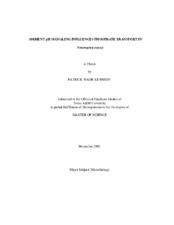Ambient pH signaling influences phosphate transport in Neurospora crassa
| dc.contributor.advisor | Versaw, Wayne K. | |
| dc.creator | Kennedy, Patrick Wade | |
| dc.date.accessioned | 2007-04-25T20:08:11Z | |
| dc.date.available | 2007-04-25T20:08:11Z | |
| dc.date.created | 2005-12 | |
| dc.date.issued | 2007-04-25 | |
| dc.identifier.uri | https://hdl.handle.net/1969.1/4796 | |
| dc.description.abstract | In the course of our efforts to resolve Pi transport mechanisms in the model fungus Neurospora crassa we identified a null mutant, par-1, that displays enhanced Pi transport activity specifically under alkaline growth conditions. The PAR-1 protein is related to PalF of Aspergillus nidulans, which is one component of an ambient pH signaling pathway that is conserved among fungi. A deletion mutant for the PacC homolog, another component of the same pathway, phenocopies par-1, demonstrating that a defect in pH signaling is responsible for the altered Pi transport activity. Our results indicate that pH signaling in N. crassa plays an important role in coordinating high and low affinity Pi transport in response to ambient pH, but through different mechanisms. Sulfate acquisition also is influenced by pH signaling, suggesting that this regulatory system has a broad role in nutrient uptake and homeostasis. | en |
| dc.format.extent | 1545103 bytes | en |
| dc.format.medium | electronic | en |
| dc.format.mimetype | application/pdf | |
| dc.language.iso | en_US | |
| dc.publisher | Texas A&M University | |
| dc.subject | phosphate | en |
| dc.subject | pH | en |
| dc.title | Ambient pH signaling influences phosphate transport in Neurospora crassa | en |
| dc.type | Book | en |
| dc.type | Thesis | en |
| thesis.degree.department | Biology | en |
| thesis.degree.discipline | Microbiology | en |
| thesis.degree.grantor | Texas A&M University | en |
| thesis.degree.name | Master of Science | en |
| thesis.degree.level | Masters | en |
| dc.contributor.committeeMember | Bell-Pedersen, Deborah | |
| dc.contributor.committeeMember | Shaw, Brian | |
| dc.type.genre | Electronic Thesis | en |
| dc.type.material | text | en |
| dc.format.digitalOrigin | born digital | en |
Files in this item
This item appears in the following Collection(s)
-
Electronic Theses, Dissertations, and Records of Study (2002– )
Texas A&M University Theses, Dissertations, and Records of Study (2002– )


